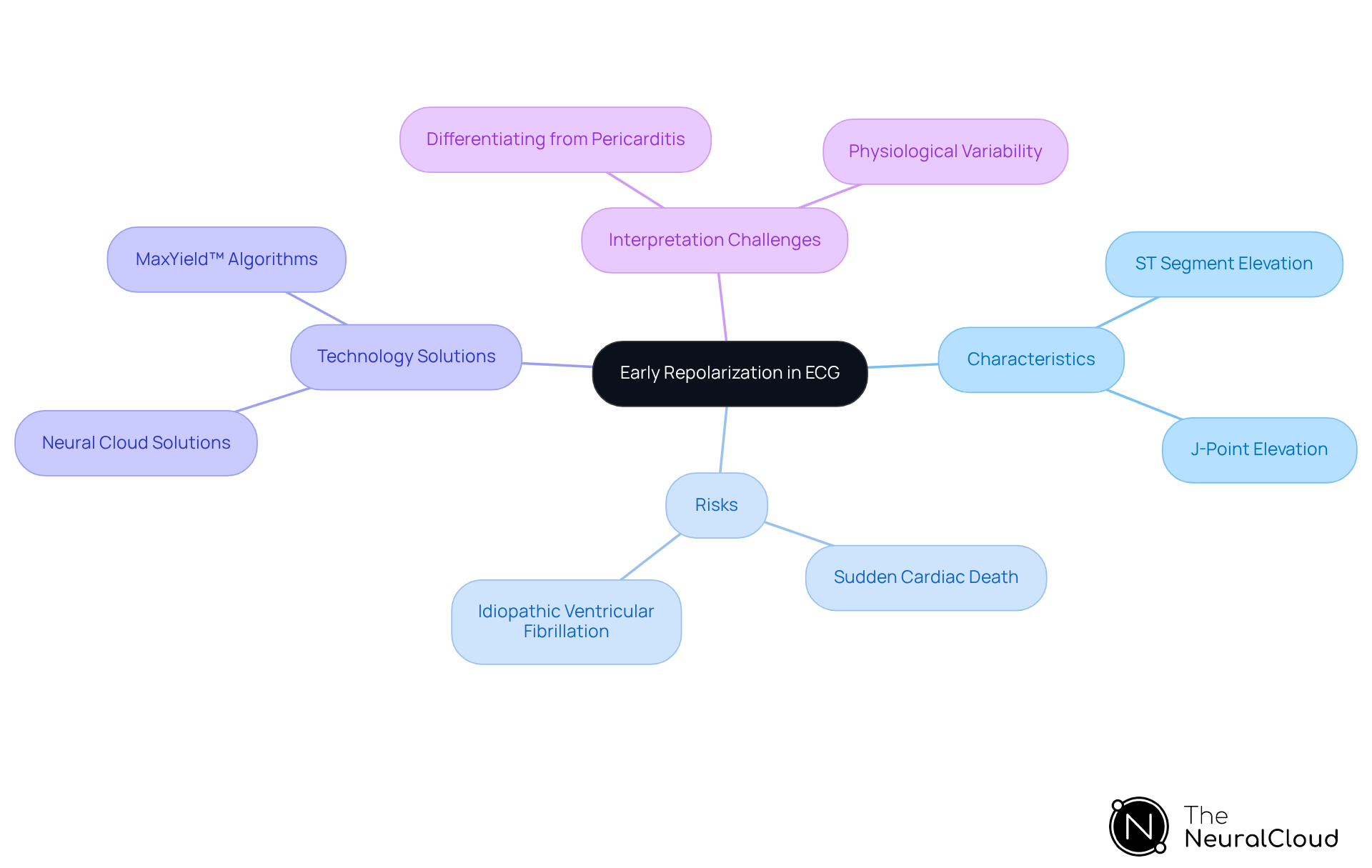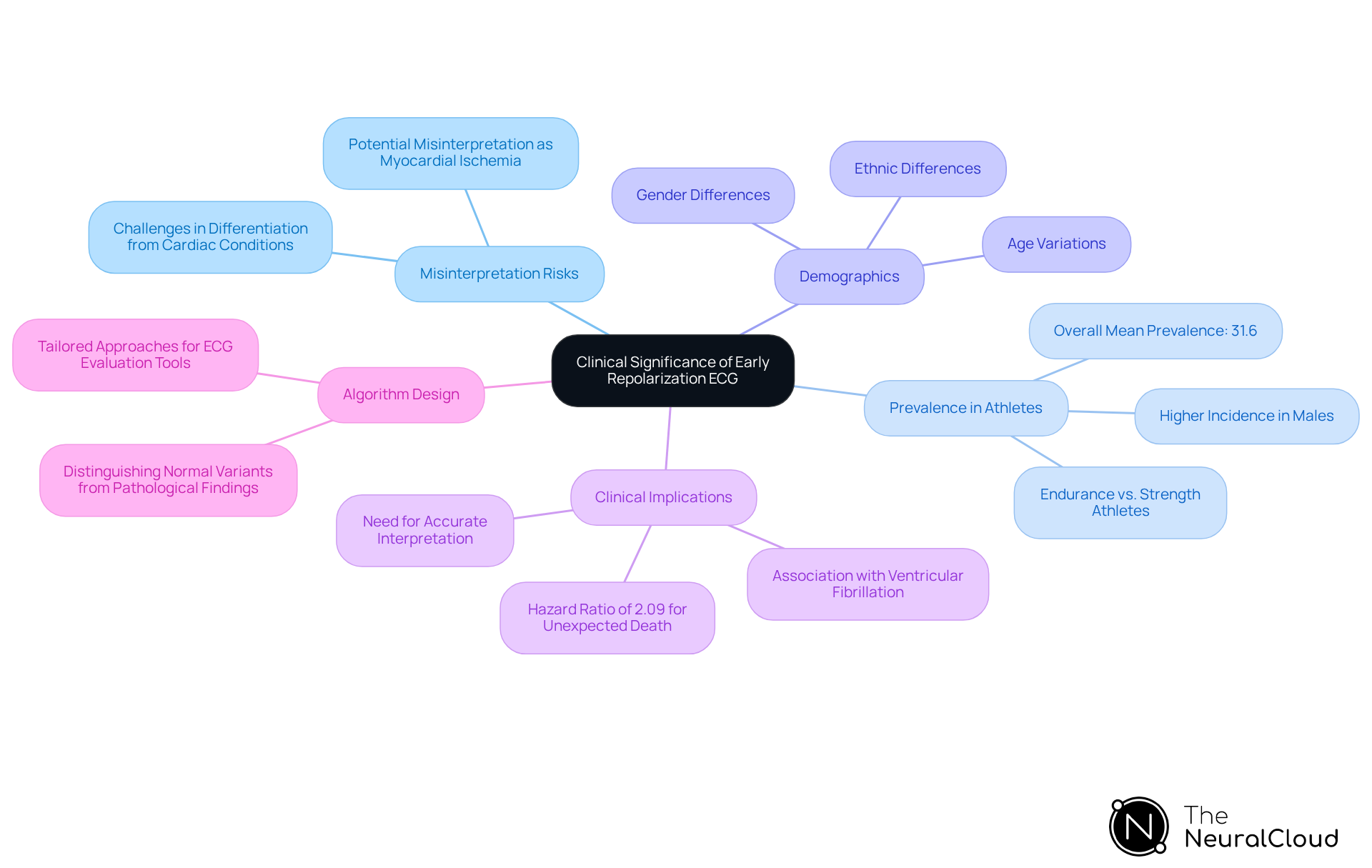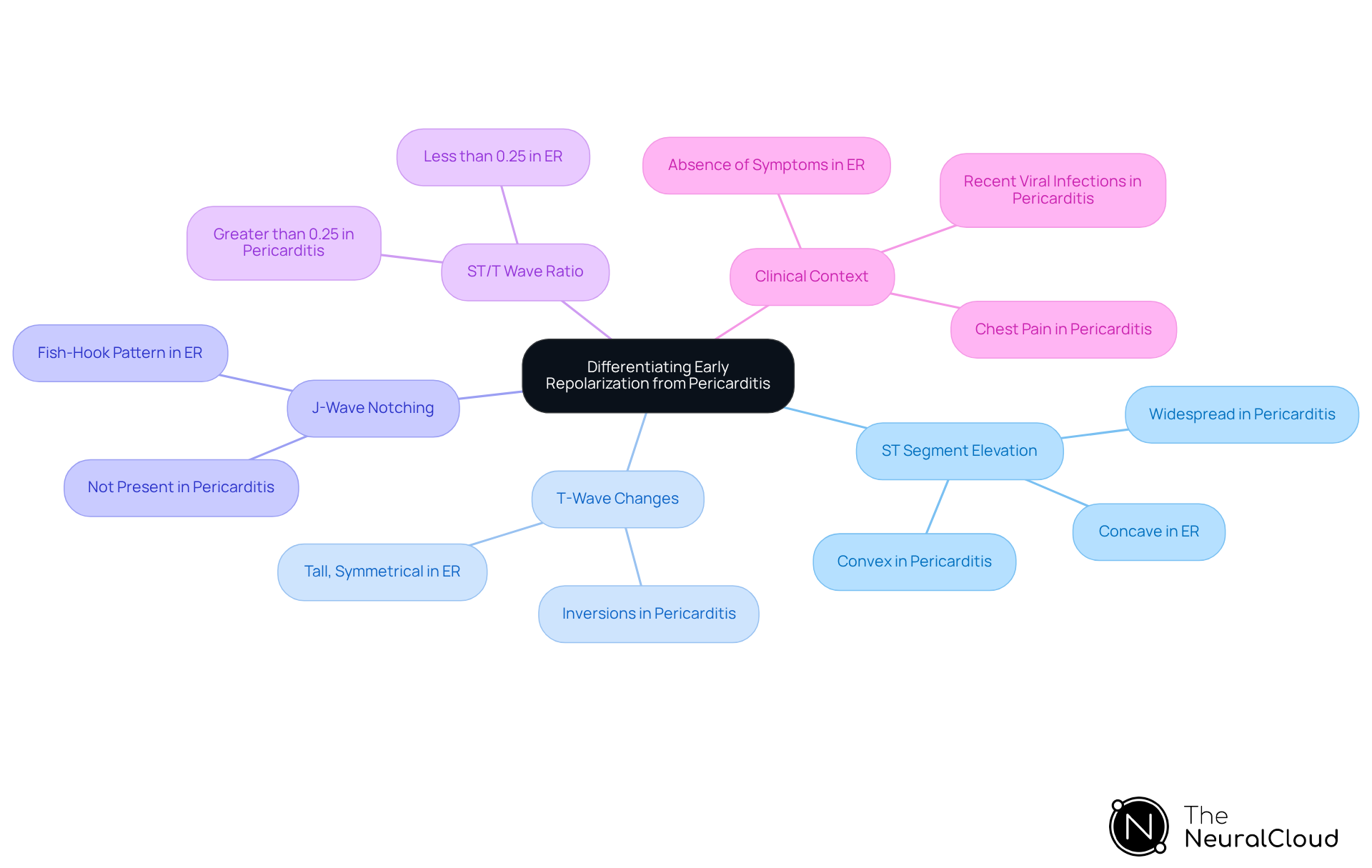Overview
Early repolarization in ECG is characterized by the early recovery of electrical activity, specifically marked by J-point elevation and ST segment configuration, often observed in healthy young individuals. Accurately identifying these features is crucial, as misinterpretation can lead to unnecessary interventions. Advanced algorithms like MaxYield™ play a significant role in enhancing diagnostic precision, allowing healthcare professionals to distinguish early repolarization from other cardiac conditions effectively.
The challenges in ECG analysis include the risk of misinterpretation due to the subtle nature of early repolarization changes. MaxYield™ addresses these challenges by employing sophisticated algorithms that improve the accuracy of ECG readings. The platform's features include enhanced signal processing, which allows for clearer visualization of the J-point and ST segment. This results in a more reliable assessment of cardiac health.
The advantages of using MaxYield™ are substantial for healthcare professionals. By providing clearer diagnostic insights, the platform reduces the likelihood of unnecessary procedures and improves patient outcomes. Furthermore, the integration of MaxYield™ into clinical practice empowers practitioners with the tools needed for precise ECG analysis, ultimately benefiting patient care.
In conclusion, the use of advanced algorithms like MaxYield™ not only enhances the identification of early repolarization but also supports healthcare professionals in making informed decisions, thereby fostering improved diagnostic accuracy and patient safety.
Introduction
Understanding the intricacies of early repolarization in ECG is essential for developers seeking to improve diagnostic accuracy in cardiac evaluations. This phenomenon, frequently misinterpreted, has significant implications for patient safety and clinical decision-making. As developers explore the nuances of early repolarization, they encounter the challenge of differentiating it from potentially life-threatening conditions like pericarditis. This task demands both precision and advanced analytical tools. To enhance their ECG analysis, developers can leverage cutting-edge technology, which can refine interpretations and ultimately safeguard patient health.
Define Early Repolarization in ECG
The early repolarization ECG reflects early recovery of electrical activity, characterized by a distinct pattern in the waveform, primarily marked by ST segment elevation without any underlying cardiac pathology. This phenomenon, known as early repolarization ECG, is frequently observed in young, healthy individuals, where it is often regarded as a normal variant. Developers must acknowledge that early repolarization ECG can manifest as J-point elevation, which may be misunderstood as pathological changes if not precisely identified. Recent research suggests that initial recovery patterns are common, appearing in about 3-5% of healthy young people.
Moreover, studies have connected specific initial recovery patterns to a heightened risk of sudden cardiac death, especially in individuals with idiopathic ventricular fibrillation. Understanding these nuances is crucial for accurate ECG interpretation and the development of . Real-world examples, such as the 'fish-hook' pattern observed in lead V4, illustrate the importance of distinguishing early repolarization ECG from other conditions like pericarditis, which can present with similar ST elevation features.
By leveraging Neural Cloud Solutions' platform, developers can utilize advanced noise filtering and wave recognition capabilities to enhance the diagnostic yield of ECG interpretations. The platform develops with every application, consistently enhancing its precision and effectiveness, which aids in tackling the issues of physiological variability and signal artifacts in ECG evaluation.
Integrating these insights with MaxYield™'s automated labeling and adaptive algorithms allows developers to overcome inefficiencies, ultimately enhancing the reliability of their ECG analysis tools.

Identify Key ECG Features of Early Repolarization
Key features of early repolarization in ECG include:
- J-Point Elevation: This prominent indicator is characterized by the J-point being elevated above the baseline. Studies indicate that J-point elevation in inferior leads is associated with a significantly increased risk of death from cardiac causes, with an unadjusted relative risk of 3.52. Notably, a groundbreaking study discovered a higher occurrence of initial cardiac resetting in 206 individuals with ventricular fibrillation compared to 412 control participants, with a hazard ratio of 2.1. The MaxYield™ system can automate the detection of J-point elevation, providing rapid analysis and labeling of this critical feature.
The ST segment configuration often appears concave upwards, which is a distinguishing characteristic of early repolarization ECG. The slope of the ST segment is crucial; horizontal or downsloping segments are linked to a higher risk of ventricular fibrillation compared to upsloping segments. The MaxYield™ system enhances workflow efficiency by quickly identifying and categorizing ST segment configurations, allowing developers to focus on refining their algorithms.
- T-Wave Morphology: T-waves may be tall and symmetrical, typically following the elevated ST segment. This morphology can provide additional insights into the underlying cardiac condition. With the MaxYield™ system, developers can utilize to ensure precise identification of T-wave features, enhancing diagnostic clarity.
- Location: Early recovery, often reflected as early repolarization ECG, is primarily observed in the precordial leads (V2-V5), although it can vary in presentation across different leads. Approximately 5% to 13% of individuals in Western populations exhibit this pattern, with higher frequencies noted in younger males and certain ethnic groups. It is also more common among men, young individuals, and black populations. MaxYield™ facilitates scalable evaluation across different leads, ensuring comprehensive coverage of ECG data.
Developers must guarantee that their algorithms can precisely identify these characteristics to efficiently distinguish initial recovery from other conditions, thus improving the diagnostic abilities of ECG evaluation software. It is essential to acknowledge that although initial recovery is linked to heightened relative risk, the actual risk of sudden cardiac arrest remains low for the majority of patients. By incorporating MaxYield™ into their platforms, developers can revolutionize ECG evaluation, utilizing automation and noise reduction for improved cardiac insights.

Discuss Clinical Significance of Early Repolarization
The clinical significance of early repolarization ECG is highlighted by its potential misinterpretation as a marker of myocardial ischemia or other cardiac conditions. While often deemed benign, the early repolarization ECG is associated with an , particularly among certain populations, such as athletes. A systematic review involving 44,326 athletes indicated an overall mean prevalence of ER at 31.6%, revealing notable variations based on demographics and athletic disciplines. For example, male and endurance athletes displayed higher incidences of ER compared to their female and strength counterparts.
Understanding these nuances is imperative for developers, as it informs the design of algorithms that must effectively distinguish between normal variants, including early repolarization ECG, and pathological findings. Studies suggest that the early repolarization ECG is linked to a hazard ratio of 2.09 for unexpected death, underscoring the necessity for accurate interpretation in clinical settings. Furthermore, the variations in definitions of early repolarization ECG across studies complicate risk evaluations, necessitating tailored approaches in ECG evaluation tools to ensure they provide relevant insights for specific patient groups.
Real-world examples demonstrate the challenges in differentiating early repolarization ECG from myocardial ischemia, which can lead to unnecessary interventions. Therefore, recognizing demographic factors, such as age and athletic status, is vital for enhancing the precision of early repolarization ECG evaluation tools. This understanding ultimately contributes to improved clinical decision-making and patient safety.

Differentiate Early Repolarization from Pericarditis
To effectively differentiate early repolarization ECG from pericarditis, developers should focus on several key aspects, leveraging the capabilities of MaxYield™ for enhanced analysis.
- ST Segment Elevation: In early repolarization, the ST segment elevation is typically concave, while in pericarditis, it is often convex and widespread across multiple leads. This distinction is crucial as it can significantly influence diagnostic outcomes. The system can automate the identification of these patterns, providing rapid insights.
- T-Wave Changes: Early recovery is characterized by tall, symmetrical T-waves, whereas pericarditis may present with T-wave inversions following the ST segment elevation. Understanding these variations is essential for precise interpretation, and the can enhance this process.
- J-Wave Notching: A significant characteristic of initial cardiac recovery is the presence of J-wave notching, frequently referred to as a fish-hook pattern, especially evident in leads V3-4. This trait can assist in differentiating initial recovery from pericarditis, and the system can emphasize these aspects in its evaluation.
- ST/T Wave Ratio: The ST segment/T wave ratio is a valuable diagnostic tool, with a ratio of less than 0.25 indicating initial recovery and greater than 0.25 suggesting pericarditis. Incorporating this metric into diagnostic algorithms can enhance accuracy, and this solution can facilitate this integration through its advanced algorithms.
- Clinical Context: Pericarditis is often linked with symptoms like chest pain and a recent history of viral infections, which are typically absent in cases of initial recovery. Integrating these clinical indicators into diagnostic algorithms can improve accuracy and reduce the risk of misinterpretation, supported by the extensive data evaluation capabilities of MaxYield™.
Statistics indicate that emergency room doctors misidentify acute myocardial infarction (AMI) as premature ventricular contraction 10% of the time and conversely 28% of the time, underscoring the significance of accurate ECG interpretation. Furthermore, the prevalence of early repolarization ECG is estimated to be between 1% and 25% of the general population, emphasizing the importance of accurate diagnosis. By concentrating on these differentiating features and utilizing MaxYield™, developers can create more effective ECG analysis tools that enhance clinical decision-making.

Conclusion
Understanding early repolarization in ECG is essential for developers aiming to enhance diagnostic accuracy in cardiac evaluations. This phenomenon, frequently observed in healthy individuals, poses challenges in interpretation, particularly when distinguishing it from pathological conditions. By comprehending the unique characteristics of early repolarization, developers can create more effective algorithms that improve ECG analysis and reduce the risk of misdiagnosis.
Key insights from the article emphasize the importance of recognizing specific ECG features such as:
- J-point elevation
- ST segment configuration
- T-wave morphology
These elements not only assist in differentiating early repolarization from conditions like pericarditis but also underscore the clinical implications of accurate interpretation. The integration of advanced tools like MaxYield™ facilitates the automation of detection and analysis of these features, ultimately enhancing the reliability of ECG evaluations.
The significance of understanding early repolarization extends beyond technical analysis; it has real-world implications for patient safety and clinical decision-making. By leveraging the insights gained from this article, developers are encouraged to refine their ECG evaluation tools, ensuring they are equipped to navigate the complexities of cardiac assessment. This proactive approach will not only enhance diagnostic precision but also contribute to improved outcomes for patients, solidifying the role of technology in modern healthcare.
Frequently Asked Questions
What is early repolarization in ECG?
Early repolarization in ECG reflects early recovery of electrical activity, characterized by a distinct waveform pattern, primarily marked by ST segment elevation without any underlying cardiac pathology.
In which population is early repolarization ECG commonly observed?
Early repolarization ECG is frequently observed in young, healthy individuals and is often regarded as a normal variant.
What is J-point elevation in the context of early repolarization ECG?
J-point elevation is a manifestation of early repolarization ECG that may be misunderstood as pathological changes if not accurately identified.
What percentage of healthy young people exhibit early repolarization patterns?
Recent research suggests that initial recovery patterns, including early repolarization, appear in about 3-5% of healthy young individuals.
What is the potential risk associated with specific initial recovery patterns in ECG?
Studies have connected certain initial recovery patterns to a heightened risk of sudden cardiac death, particularly in individuals with idiopathic ventricular fibrillation.
Why is it important to distinguish early repolarization ECG from other conditions?
Distinguishing early repolarization ECG from conditions like pericarditis is crucial because they can present with similar ST elevation features, which can lead to misinterpretation.
How can developers enhance the diagnostic yield of ECG interpretations?
Developers can enhance the diagnostic yield by leveraging Neural Cloud Solutions' platform, which offers advanced noise filtering and wave recognition capabilities.
What benefits do MaxYield™'s automated labeling and adaptive algorithms provide?
MaxYield™'s automated labeling and adaptive algorithms help developers overcome inefficiencies in ECG analysis, ultimately enhancing the reliability of their tools.






